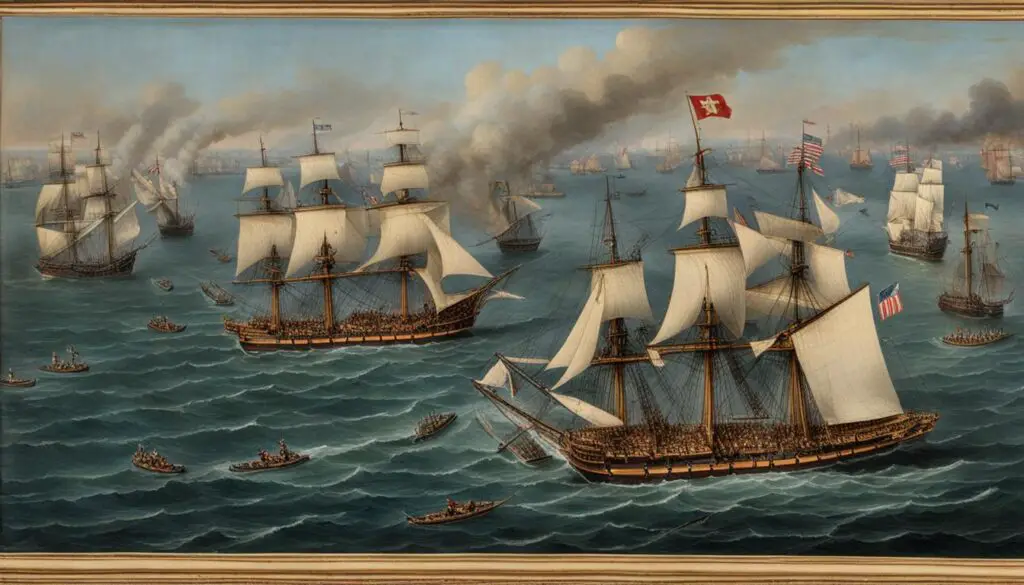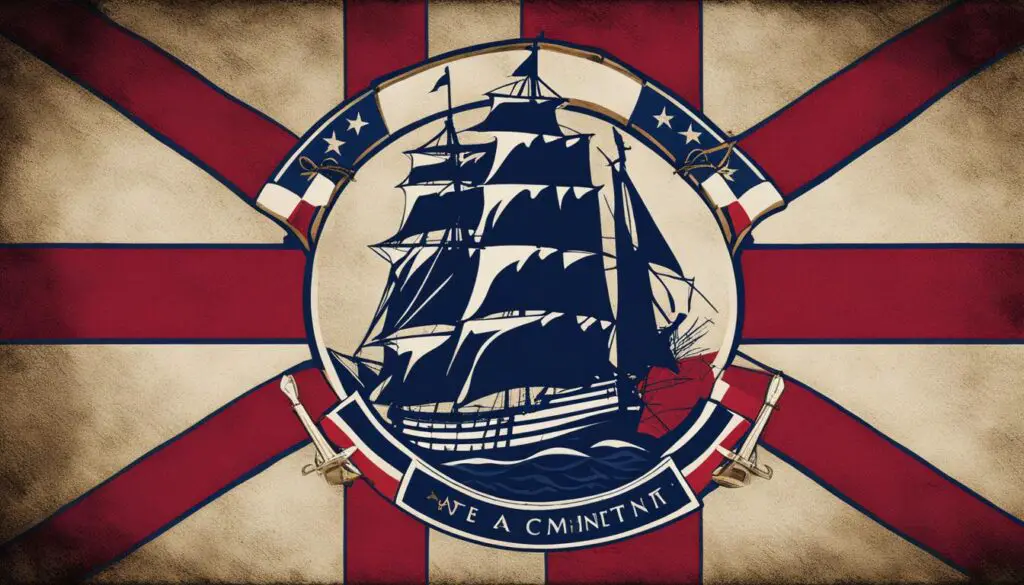The British Flag 1776 holds a fascinating history and symbolism that reflects its origins and significance. From its design to its historical context, exploring the meaning behind this iconic flag provides a deeper understanding of the stories it tells and the values it represents.
Key Takeaways:
- The British Flag 1776 carries rich symbolism and historical significance.
- Understanding the design and meaning of the flag provides insights into its origins.
- The historical context of the British Flag 1776 sheds light on the time in which it was created.
- Exploring the stories behind the flag helps to unravel its deeper symbolism.
- The British Flag 1776 is an enduring symbol of heritage and national identity.
The Betsy Ross Flag: The First Official Flag of the United States
The Betsy Ross flag, known as the first official flag of the United States, holds a significant place in American history. Designed during the American Revolution, this flag features 13 white stars in a circle on a blue field, representing the original 13 colonies, along with 13 alternating red and white stripes. The Flag Act of 1777 officially adopted this design as the national flag, solidifying its place as a symbol of the young nation’s unity and independence.
According to legend, Betsy Ross, an American upholsterer, was commissioned by several Founding Fathers, including George Washington, to create the flag. She made changes to the initial 6-pointed stars, transforming them into 5-pointed stars for easier production. The Betsy Ross flag played a crucial role during the early days of the American Revolution, rallying the colonists behind a common emblem as they fought for their freedom.
The Betsy Ross flag: a symbol of unity and revolution.
During the American Revolution, the Betsy Ross flag served as a symbol of unity and defiance against British rule. It represented the aspirations of the 13 colonies and their determination to establish a new nation. The stars and stripes of the flag became a powerful emblem of American patriotism and continue to evoke a sense of pride and heritage to this day.
The Gadsden Flag: A Symbol of American Unity
The Gadsden flag is a powerful symbol of American unity, representing the resilience and determination of the American people during a crucial time in history. Designed in 1775 during the American Revolution, this flag became an iconic representation of the colonies’ unity against British oppression.
The flag features a coiled rattlesnake, a creature that had already become a symbol of the American colonies’ determination and resistance. The defiant message “Don’t Tread on Me” written below the snake served as a warning to the British forces, a reminder that the colonies would not be easily dominated.
The Gadsden flag played a significant role in rallying support for the American cause, evoking a sense of patriotism and inspiring the colonists to stand together in their fight for freedom. Its striking design and strong symbolism continue to resonate with Americans today, symbolizing the perseverance and unwavering spirit that define the nation.
| Rattlesnake Symbolism | American Revolution | British Oppression |
|---|---|---|
| The rattlesnake, a native American species, was already associated with the American colonies before the Revolution. Its image was used on various propaganda materials as a symbol of resistance and readiness to strike. | The American Revolution was a period of intense struggle for independence from British rule. The Gadsden flag became a powerful symbol of unity and defiance during this crucial time in American history. | The flag represented the colonies’ resistance against British oppression and the determination to assert their rights and freedoms. It served as a symbol of the colonists’ refusal to be subjugated by a foreign power. |
In conclusion, the Gadsden flag stands as a testament to the spirit of American unity and resistance. Its bold design and powerful symbolism continue to inspire and remind us of the values upon which the nation was founded. The flag represents the courage and determination of the American people, both in the past and present, and serves as a timeless symbol of freedom.
The Grand Union Flag: A Transitional Flag in American History
The Grand Union Flag, also known as the Continental Colors or the Union Jack, holds a unique place in the narrative of American flags. Raised on January 1, 1776, this flag marked a pivotal moment in the nation’s journey towards freedom during the American Revolution.
The design of the Grand Union Flag was a combination of the British Union Jack and 13 alternating red and white stripes representing the colonies. Unlike later versions of the American flag, the Grand Union Flag did not yet feature stars. Instead, it symbolized the colonists’ quest for a redress of grievances from Britain rather than complete independence.
This transitional flag stands as a visual representation of the complicated relationship between the American colonies and the British Empire at that time. It reflects the colonists’ desire for greater autonomy and the gradual shift towards the establishment of an independent nation. The Grand Union Flag serves as a reminder of the courage and determination displayed by the early American patriots in their quest for freedom.
The Evolution of the American Flag
The Grand Union Flag played a significant role in the evolution of the American flag. It paved the way for the iconic Stars and Stripes that would come to symbolize the United States. The design of the flag evolved over time, with subsequent flag resolutions defining its appearance as new states were added to the Union.
The Grand Union Flag represents a crucial chapter in American history, showcasing the complex and multifaceted journey towards independence. Its significance lies not only in its design but also in the ideals and aspirations it embodies.
| Flag | Date | Description |
|---|---|---|
| Grand Union Flag | January 1, 1776 | Combination of the British Union Jack and 13 alternating red and white stripes representing the colonies |
| Stars and Stripes | June 14, 1777 | Thirteen alternating red and white stripes, and a blue field with white stars representing a new constellation |
Through the evolution of the American flag, from the Grand Union Flag to the Stars and Stripes, the nation’s rich history and the spirit of independence are preserved, reminding us of the sacrifices made by those who came before us.
The Commodore Perry Flag: A Tribute to Naval Officer James Lawrence
The Commodore Perry flag, also known as the tribute flag, was designed as a tribute to naval officer James Lawrence. Perry ordered the flag to be stitched with the phrase “Don’t give up the ship” after Lawrence’s famous last words during a battle in the War of 1812. This flag honors Lawrence’s bravery and serves as a reminder of the sacrifices made by American naval officers.
“Don’t give up the ship.”
The Commodore Perry flag holds historical significance within the context of the War of 1812. It pays homage to the courage and resilience of James Lawrence, a naval officer who made a lasting impact on American history. In one of the most memorable moments of the war, Lawrence’s dying words became a rallying cry for the Navy and a symbol of unwavering determination.
As the flag bearing Lawrence’s powerful statement, the Commodore Perry flag represents the valor and determination of American naval officers. It stands as a testament to their commitment to duty and their willingness to fight for their country, even in the face of adversity.

The Legacy of James Lawrence
James Lawrence’s legacy lives on through the Commodore Perry flag and the enduring spirit it represents. His words and actions during the War of 1812 continue to inspire and remind us of the sacrifices made by those who serve in the United States Navy. The flag serves as a symbol of honor, courage, and unwavering dedication to defending our nation’s freedom.
| Flag | Design | Significance |
|---|---|---|
| Commodore Perry Flag | White field with the phrase “Don’t give up the ship” | Honoring the bravery and sacrifice of naval officer James Lawrence |
The Continental Flag: Symbol of New England

The Continental flag, with its representation of an eastern white pine, symbolized New England during the American Revolution. It is prominently featured in John Trumbull’s painting depicting the Battle of Bunker’s Hill. The flag’s red coloring is derived from the Red Ensign of Britain’s Royal Navy, demonstrating the ties and conflicts between the colonists and the British.
The eastern white pine, known for its tall stature and strength, was an important symbol of the region’s rich natural resources and its resilience in the face of adversity. By incorporating the eastern white pine into the flag design, the Continental flag represented the unity and determination of the New England colonies in their fight for independence.
“The Continental flag with its representation of the eastern white pine visually captured the spirit of New England during the American Revolution. Its presence in Trumbull’s painting and its symbolism in the war effort underscore the significance of this flag in our nation’s history.”
Furthermore, the Continental flag serves as a reminder of the sacrifices made by the brave soldiers who fought at the Battle of Bunker’s Hill, a significant early engagement in the Revolutionary War. The flag’s inclusion in Trumbull’s painting immortalizes the flag and the momentous events it represents. It stands as a tribute to the courage and determination of the patriots who fought for the birth of a new nation.
| Symbolism | Meaning |
|---|---|
| Eastern White Pine | Resilience, natural resources |
| Red Ensign | Conflicts and ties with Britain |
| Prominence in Trumbull’s painting | Significance in American history |
| Battle of Bunker’s Hill | Patriotic sacrifice and courage |
The Continental flag, with its distinctive design and rich symbolism, serves as a lasting testament to the spirit and determination of New England during the American Revolution. As a symbol of unity and resilience, it continues to inspire and remind us of the sacrifices made by those who fought for the birth of our nation.
The Washington Cruisers Flag: Flag of Frigates Under George Washington’s Command
The Washington Cruisers flag, also known as the Pine Tree Flag, played a significant role during the American Revolution. This flag was used by frigates under the command of George Washington and later became the official flag of the Massachusetts State Navy. Its design, featuring a white pine tree on a blue background, symbolized the strength and unity of the American colonies in their fight for independence.
The Washington Cruisers flag was suggested by Colonel Joseph Reed, who served as Washington’s secretary. The flag’s design was inspired by the use of pine trees as a symbol of freedom in New England, representing the resilience and determination of the American people in their quest for liberty. The flag was hoisted on naval ships under Washington’s command and served as a powerful symbol of resistance against British oppression.
The Pine Tree Flag is a testament to the bravery and resilience of the American naval forces during the Revolution. Its presence on frigates under Washington’s command instilled a sense of pride and unity among the sailors, reminding them of their mission to defend their newfound nation. The flag’s legacy lives on as a symbol of the sacrifices made by those who fought for American independence.

The Washington Cruisers Flag in the American Revolution
The Washington Cruisers flag played a crucial role in naval operations during the American Revolution. It symbolized the determination and resolve of the American sailors and officers who fought against the powerful British Navy. By flying the Pine Tree Flag on their ships, they proudly showcased their allegiance to the cause of American independence.
The flag’s significance extended beyond its role in the Revolution. After the war, it became the official flag of the Massachusetts State Navy and continued to be used as a symbol of patriotism and naval power. Its design and symbolism captured the spirit of the American people and served as a reminder of their fight for freedom.
| Flag Name | Design | Significance |
|---|---|---|
| Washington Cruisers Flag | White pine tree on a blue background | Symbolized unity and resilience of American colonies in the Revolution |
| Pine Tree Flag | Used by frigates under George Washington’s command | Represented resistance against British oppression |
| Official flag of the Massachusetts State Navy | Became the official flag of the Massachusetts State Navy | Continued to symbolize patriotism and naval power |
The First Navy Jack: From Stripes to Rattlesnakes
The First Navy Jack is a flag with a fascinating evolution that reflects the history and identity of the United States Navy. Originally featuring a striped design, this flag later incorporated a rattlesnake and the phrase “Don’t tread on me.” It holds a special significance as the flag flown on the longest active-status warship and represents the Navy’s commitment to protecting American interests.
The Continental Navy
The First Navy Jack has its roots in the Continental Navy, the precursor to the modern U.S. Navy. Established in 1775, the Continental Navy played a crucial role during the American Revolution, protecting American trade and challenging British naval dominance. The First Navy Jack symbolizes the Navy’s early efforts to assert its independence and assert the nation’s sovereignty.
“Don’t tread on me.”
The phrase “Don’t tread on me,” featured on the First Navy Jack, is a powerful statement of defiance and determination. It originated from Christopher Gadsden, a leader in the American Revolution, who designed a flag depicting a coiled rattlesnake and the words “Don’t tread on me.” The flag became a symbol of resistance against British oppression and a rallying cry for American patriots.
| Flag Design | Features |
|---|---|
| Striped Design | Originally had alternating red and white stripes |
| Rattlesnake | Later incorporated a coiled rattlesnake |
| “Don’t tread on me” | Phrase added to signify defiance |
The First Navy Jack holds a prominent place in the history and identity of the U.S. Navy. Serving as a symbol of independence, resistance, and the Navy’s commitment to defending the nation, this flag represents the enduring values and principles of the United States.
The American Revolution and the Flag Evolution
The American Revolution was a transformative period in the history of the United States, and it played a significant role in the evolution of the country’s flag. As the colonists fought for independence from British rule, they sought a symbol that would represent their new nation and its values.
During the early stages of the revolution, the Continental Colors flag was used to represent the colonies. This flag featured a design similar to the British Red Ensign, with alternating red and white stripes symbolizing the original 13 colonies. However, as the conflict progressed, the colonists desired a distinct flag that would reflect their growing identity as a separate nation.
In 1777, the Continental Congress passed the Flag Resolution, which established the design of the Stars and Stripes. This iconic flag incorporated the alternating red and white stripes representing the colonies, a blue field in the canton, and a constellation of white stars symbolizing the states. The design of the Stars and Stripes has remained largely unchanged since then, with the number of stars increasing as new states joined the Union.
This evolution of the flag reflected the changing aspirations of the American people. The Continental Colors flag represented a desire for redress of grievances within the British Empire. However, as the revolution progressed, the colonists’ goals shifted towards complete independence and the establishment of a new nation. The Stars and Stripes became a powerful symbol of this newfound unity and provided a visual representation of the ideals and values for which the colonists were fighting.
Flag Evolution Timeline:
| Flag | Description | Year |
|---|---|---|
| Continental Colors | 13 alternating red and white stripes | 1775 |
| Grand Union Flag | Union Jack in the canton, 13 alternating red and white stripes | 1775-1777 |
| Stars and Stripes | 13 alternating red and white stripes, blue canton with white stars | 1777-present |
The evolution of the American flag during the revolution represented the journey of the colonists towards self-governance and independence. Through the design and symbolism of the Stars and Stripes, the flag became a powerful emblem of the American identity and the principles on which the nation was founded.
Symbolism and Significance of the Stars and Stripes
The Stars and Stripes, the most recognizable flag of the United States, holds significant symbolism and represents the values and ideals of the nation. Each element of the flag has a specific meaning that reflects the principles on which the country was founded. The colors of the flag, red, white, and blue, carry deep symbolism. Red represents hardiness and valor, white symbolizes purity and innocence, while blue signifies vigilance, perseverance, and justice. These colors together embody the spirit and resilience of the American people.
The Stars and Stripes play a central role in expressions of American patriotism. For example, the recitation of the Pledge of Allegiance is an important tradition in schools and public gatherings. The pledge affirms loyalty and devotion to the flag and the ideals it represents. Additionally, the singing of the national anthem, “The Star-Spangled Banner,” is a powerful moment that unites Americans in a shared sense of pride and patriotism. The flag serves as a visual embodiment of the lyrics, inspiring emotions of unity and determination.
“I pledge allegiance to the Flag of the United States of America and to the Republic for which it stands, one Nation under God, indivisible, with liberty and justice for all.” – The Pledge of Allegiance
As a national symbol, the Stars and Stripes have also sparked debates and discussions regarding freedom of expression. Some argue that flag desecration should be protected as a form of free speech, while others believe that protecting the flag from physical harm is important for preserving its symbolic value. These discussions highlight the enduring importance and impact of the American flag as a symbol of the nation’s identity and ideals.
| Flag Color | Meaning |
|---|---|
| Red | Hardiness and valor |
| White | Purity and innocence |
| Blue | Vigilance, perseverance, and justice |
In conclusion, the Stars and Stripes hold immense symbolism and significance as the flag of the United States. Its colors represent the values and virtues of the American people, while traditions like the Pledge of Allegiance and the national anthem reinforce the flag’s importance in fostering unity and patriotism. The ongoing debates surrounding flag desecration demonstrate the enduring power and influence of this national symbol. The Stars and Stripes continue to inspire and evoke a sense of pride and belonging, reminding Americans of their shared history and the ideals upon which their nation was built.
Conclusion
The influence of the British on the Founding Fathers cannot be denied. Their British heritage and experiences shaped their perspectives and contributed to the unique story of the United States. However, despite this influence, the Founding Fathers’ loyalty to America and their commitment to independence from the British Crown remained steadfast.
Throughout history, the American flags mentioned in this article symbolize different periods and aspects of American history. From the Betsy Ross flag, which represented the early days of the American Revolution, to the Stars and Stripes, the most recognizable flag of the United States today, each flag holds significance and contributes to the rich tapestry of the nation’s story.
The Founding Fathers signed significant documents, made crucial decisions, and fought for the establishment of the United States. Their dedication to liberty and their unwavering commitment to their new nation demonstrate their resolve and vision. The flags they created and rallied behind reflect their deep beliefs and aspirations for freedom.
FAQ
What does the Betsy Ross flag represent?
The Betsy Ross flag, the first official flag of the United States, represents the original 13 colonies and played a significant role in the early days of the American Revolution.
What is the symbolism behind the Gadsden flag?
The Gadsden flag, featuring a rattlesnake, symbolizes American unity and resistance against British oppression during the American Revolution.
What is the significance of the Grand Union Flag?
The Grand Union Flag, also known as the Continental Colors or the Union Jack, represented the colonists’ quest for redress of grievances from Britain and marked a pivotal moment in the nation’s journey towards freedom.
Why was the Commodore Perry flag designed?
The Commodore Perry flag was designed as a tribute to naval officer James Lawrence and honors his bravery during a battle in the War of 1812.
What does the Continental flag symbolize?
The Continental flag, with its representation of an eastern white pine, symbolized New England during the American Revolution and demonstrated the ties and conflicts between the colonists and the British.
How did the Washington Cruisers flag contribute to the American Revolution?
The Washington Cruisers flag, also known as the Pine Tree Flag, was used by frigates under George Washington’s command and played a significant role in naval operations during the American Revolution.
What is the significance of the First Navy Jack?
The First Navy Jack, featuring a rattlesnake and the phrase “Don’t tread on me,” represents the Navy’s commitment to protecting American interests and holds the distinction of being the flag flown on the longest active-status warship.
How did the American Revolution impact the evolution of the flag?
The American Revolution marked a turning point in the history of the United States and led to the evolution of the flag from the Continental Colors and the Grand Union Flag to the iconic Stars and Stripes.
What does the Stars and Stripes represent?
The Stars and Stripes, the most recognizable flag of the United States, represents purity, innocence, hardiness, valor, vigilance, perseverance, and justice. It holds significant symbolism and is central to expressions of patriotism.
How did the British influence the Founding Fathers?
The British influence and heritage of the Founding Fathers shaped their perspectives and experiences. However, their loyalty to America and their commitment to independence were unwavering, as demonstrated by their crucial decisions and actions.
Source Links
- https://libertyembers.com/were-founding-fathers-british-loyalties/
- https://www.flags.com/blog/historical-flags-stories-iconic-flags-history/
- https://www.jagranjosh.com/general-knowledge/flag-of-united-states-of-america-1688559750-1

